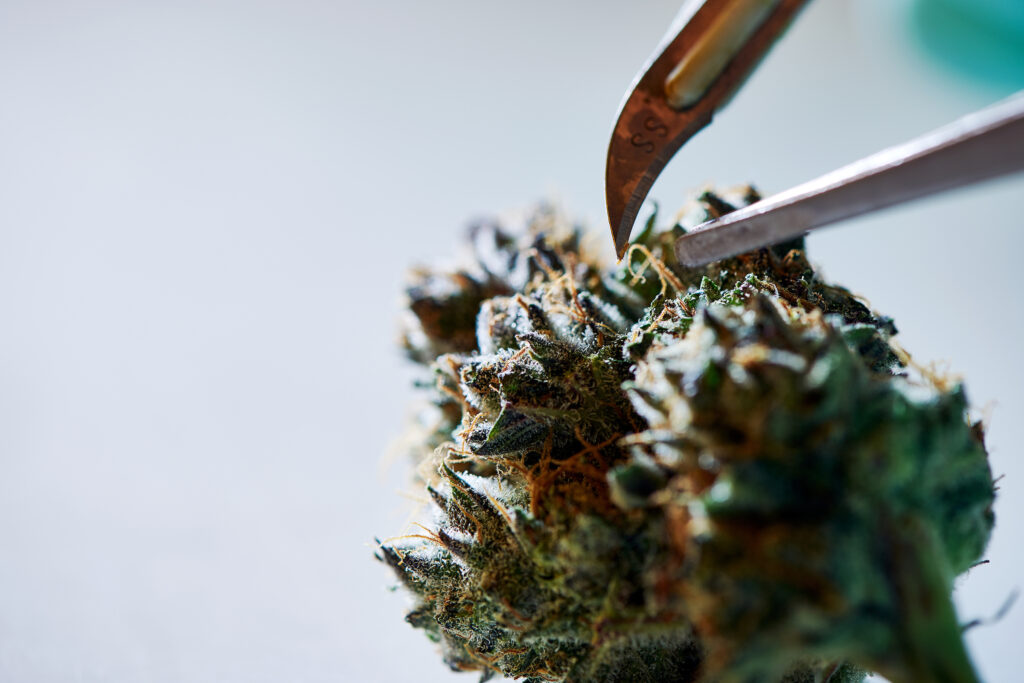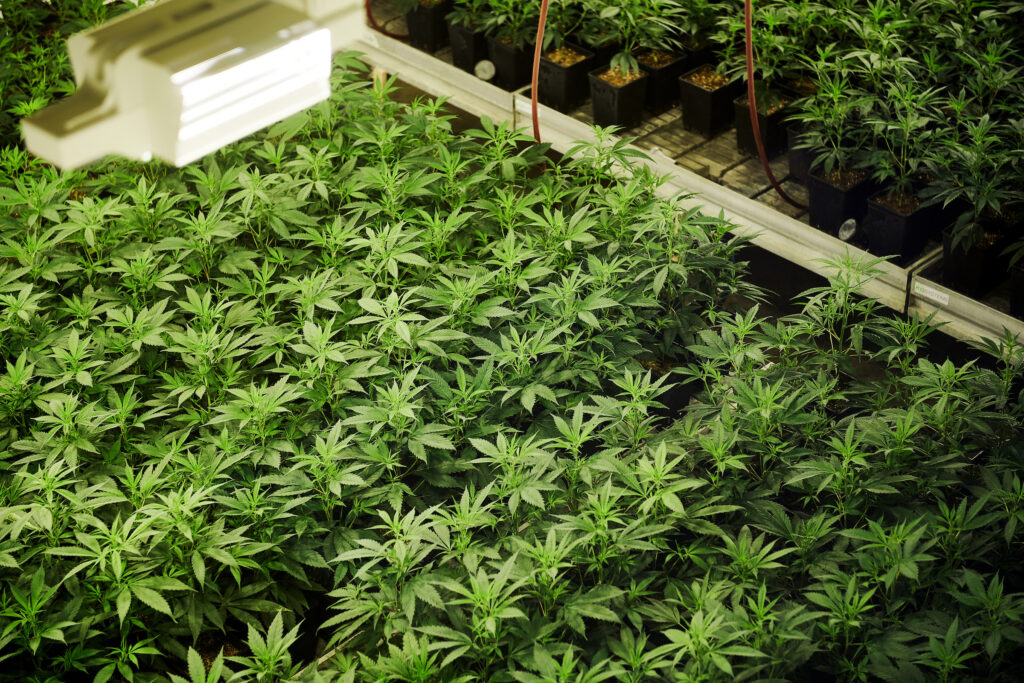What is CBD and how does it work?
The active ingredient cannabidiol (CBD)
CBD (cannabidiol) is one of 104 active compounds of cannabis (called cannabinoids) discovered so far. In recent years, CBD concentrations in commercial and industrial hemp have been increased through breeding. Like all cannabinoids, CBD is mainly present as an acid in the plant (CBD carboxylic acid).
Unlike the active ingredient THC (tetrahydrocannabinol) – also a natural cannabinoid – CBD is not psychoactive, which means CBD does not cause intoxication. Cannabis products with a THC concentration of more than 1% are illegal in Switzerland.
Detailed information on CBD and THC, as well as the effects of various cannabinoids, can be found at The Green Oasis.

CBD effect
There are numerous scientific studies on the effect of CBD, but no recognized professional studies have been published on this yet. According to the Therapeutic Products Ordinance of Switzerland, it is therefore prohibited to make healing promises – CBD-containing products are not remedies.
However, CBD’s medicinal potential is gaining momentum: presumably, CBD has nerve-protective effects and promotes healing and relief of various diseases, including schizophrenia, depression, inflammation, and headaches. Even in high doses, no relevant side effects have been reported to date, so taking the drug is considered risk-free.
In the course of research into natural cannabinoids, the body’s endocannabinoid system was also discovered. Endocannabinoids are natural substances present in the human body that play a role in almost every organ system. Among other things, this subsystem of the nervous system regulates the sensation of pain, controls memory, and controls the immune system. Endocannabinoids act, among others, on the receptors CB1 and CB2 and thereby trigger various signaling pathways. CBD interacts only weakly with the receptors of the endocannabinoid system. Rather, it inhibits the breakdown of endocannabinoids and thus enhances the effect of the body’s own substances.
CBD risks
There are hardly any known risks associated with the consumption of CBD. However, CBD should not be taken during pregnancy, as CBD can reduce the protective function of the placenta and alter its properties (see also: Addiction Switzerland).
Interactions could exist in conjunction with other medications. CBD is broken down in the liver, inhibiting certain enzymes responsible for drug breakdown. If you are already taking medication, please consult your doctor.
Legal information about CBD
For Switzerland
Every product available on herbadiberna.ch is legally available and consumable in Switzerland. According to Art. 4 para 1 lit a Therapeutic Products Ordinance we are not authorized to advise on health implications of CBD and hold that CBD is not intended for the prevention, diagnosis, treatment and cure of diseases. In Switzerland, cannabis products with a THC content of up to 1% are legal. Further information can be found in the leaflet published by the Federal Office of Public Health (FOPH) and swissmedic (PDF, 314 KB).
Further, we do not recommend driving a vehicle after consuming any of our products. Driving ability could be impaired. Minute amounts of THC can be displayed in the blood and prosecuted in traffic (for more info, see TCS).
For the EU
Outside of Switzerland, consumption and possession of the products we distribute may be subject to criminal prosecution. The following limits for commercial hemp apply in EU countries (as of October 2020):
- 1.0% THC: Switzerland
- 0.6% THC: Italy
- 0.3% THC: Austria, Czech Republic, Luxembourg
- 0.2% THC: Germany, France, Holland, Belgium, Bulgaria, Poland, Portugal, Great Britain, Croatia, Lithuania, Cyprus, Spain, Greece, Hungary, Ireland, Denmark, Finland, Estonia, Latvia, Malta, Romania, Slovenia
- 0.0% THC: Slovakia
This list is not binding. Please check the current legal situation of the respective countries before placing an order.
Hemp and its history
What is hemp?

Hemp (scientific name: cannabis) is one of the oldest useful plants of mankind. The separately-sexed hemp plant can grow up to four meters high and blooms annually. It probably originated in the Mongolian and South Siberian regions of Central Asia. Today it can be found in almost all temperate to tropical zones. The individual components of cannabis (fibers, seeds, leaves and flowers) are used in different areas – for example, in the textile industry, in the construction industry or as medicines.
Origin and distribution
The first recorded cultivation of hemp was found by archaeologists in clay pots in what is now Taiwan. Around 5000 BC in the Mongolian and South Siberian regions, the plant was used to make clothing, ropes and paper, but also oil and food were obtained from the seeds. In the collection “Classics of medicinal herbs according to Shennong” of the original emperor of the same name, cannabis was mentioned for the first time as a medicinal remedy. Cannabis was used especially to relieve pain and against gout.
The useful plant found its way between 2000 and 1000 BC via Korea to India, where further applications for textiles, as a food source and as a strong medicine were added. Around 1400 BC, cannabis reached the Indo-European nomads of the Scythians, who brought the plant as far as southern Russia and what is now Ukraine. From here it spread throughout Europe, Africa and across the globe.
Cannabis is banned and decriminalized again
When cannabis made its way to the United States from Mexico in 1910 to 1911 with the many immigrants, the tumultuous war on drugs began. Cannabis fell into disrepute and was criminalized – it was first banned in Utah in 1915, and in another 28 states by 1931. The Federal Bureau of Narcotics’ Marijuana Tax Act prohibited all possession and use of cannabis in the United States beginning in 1937 – whether it was cannabis with psychoactive ingredients or simply hemp. Even today, the U.S. federal government lists marijuana as the number one substance to control. Arguing that it has a high potential for abuse and addiction, the positive properties for medical use are excluded.
In the meantime, the view has changed in other countries: The use of marijuana was decriminalized in the Netherlands in 1976, and since 1980, sales in so-called “coffee shops” have also been permitted. Spain allows responsible use in private cannabis clubs, and the Czech Republic allowed the purchase of medical cannabis for patients with a valid prescription. This is now also the case in many U.S. states.
Today, cannabis is finding its way back into our society thanks to numerous scientific researches and clear evidence of its medicinal potential.
Sources:
- Franjo Grotenhermen, Markus Berger and Kathrin Gebhardt: Cannabidiol (CBD): A cannabis compendium . Nachtschatten Verlag, 2017
- Roger G. Pertwee (ed.): Handbook of Cannabis. Oxford University Press, 2014
- Robert C. Clarke and Mark D. Merlin: Cannabis, Evolution and Ethnobotany. University of California Press, 2013
- Bernhard van Treeck: Das große Cannabis-Lexikon – Alles über die Nutzpflanze Hanf. Lexicon Imprint Publishing House, Berlin 2000
- Bócsa, Karus, Lohmeyer: The cultivation of hemp – botany, varieties, cultivation and harvesting, markets and product lines. Agricultural publishing house, 2000




